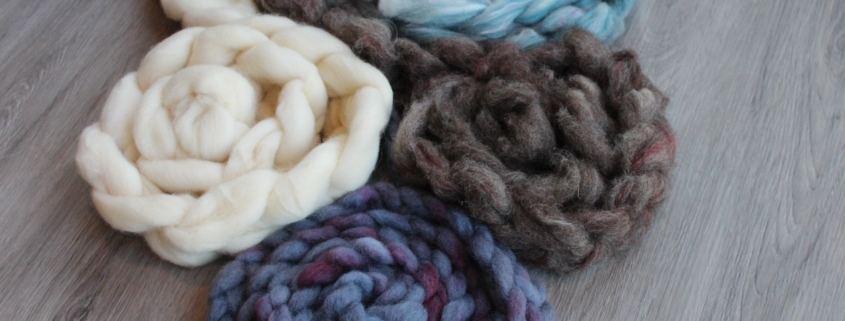The Beauty of Farm Blend Roving
words by Jacqueline Harp | photos by Susan and Patricia Harp
If you want to reach another level in spinning fibers, check out a farm blend roving! Farm blend roving is a woolen preparation made with two or more types of fiber. Typically available in small batches, it can be either hand processed or professionally milled. What makes it special, however, is that it comes from small fiber farms, making it a truly artisanal spinning fiber. It provides a fiber adventure that varies from year to year and place to place. Let’s look at farm blend roving from four different farms, and experience the smorgasbord of fun and delight for the adventurous handspinner.
Let’s Meet Our Farmers
This article would not be possible without the generosity of the four shepherdesses who produced the rovings we are enjoying here today. It is important to recognize that each braid of roving represents the hard work and creativity of four women who are dedicated to the care of their fiber-producing animals.
Arlene Vasquez of Wild Wool Farm LLC, Tacoma, WA. Because Arlene has a passion for heritage breeds, she raises many sheep breeds: Navajo Churro, Icelandic, Jacob, Border Leicester, Lincoln, Wensleydale, and Black Welsh Mountain. Her farm blend roving is a splendid combination of color, sparkle, and softness. Incredibly, her roving contains seven different fibers: Navajo-Churro, BFL, Merino, milk fiber, Angelina, and sari silk. The soft, downy undercoat from Arlene’s Navajo-Churro sheep – a dual-coated, rare heritage breed – lends a hint of resilience and elasticity to the blend.
Heidi Dennistoun of Dennistoun Farms, Arlington, WA. Heidi raises a flock of Border Leicester sheep. She hand processes much of her own raw fleeces whenever time allows. Her farm blend roving is a cheerful mix of natural chocolate brown Border Leicester and bright red Firestar. These fibers are highly lustrous, making a very glossy and glitzy blend.
Jami Beintema of Cooke Creek Sheep Company, Ellensburg, WA. Jami raises a flock of Texel, Border Leicester, and Coopworth sheep. Jami is a resourceful shepherdess, fiber artist, and certified wool classer who can find a use for almost every part of her sheep’s fleeces. Her farm blend roving is elegantly indie dyed with multiple shades of purple. The wool from two different sheep breeds are blended in this roving: Border Leicester and Coopworth. These sheep have many fleece traits in common, allowing this blend have a generous staple length (over 4 inches) and a soft yet strong handle.
Sheri Powers of Wind Dance Ranch, Ellensburg, WA. Sheri raises a flock of Border Leicesters, Bluefaced Leicesters, and Gotland sheep. Her farm blend roving is beautiful, plush, and naturally cream colored. All four sheep breeds found in Sheri’s flock are featured in this wool blend. The roving has a subtle, satin-like glow, and it feels luxuriously thick when squished.
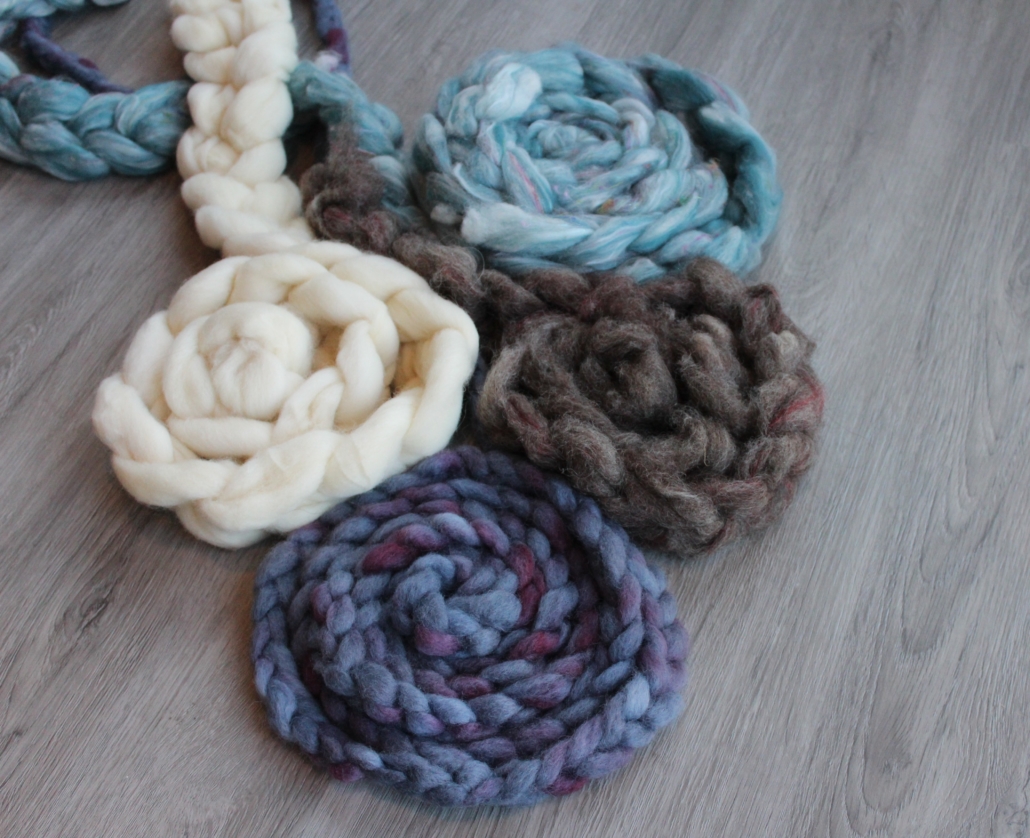
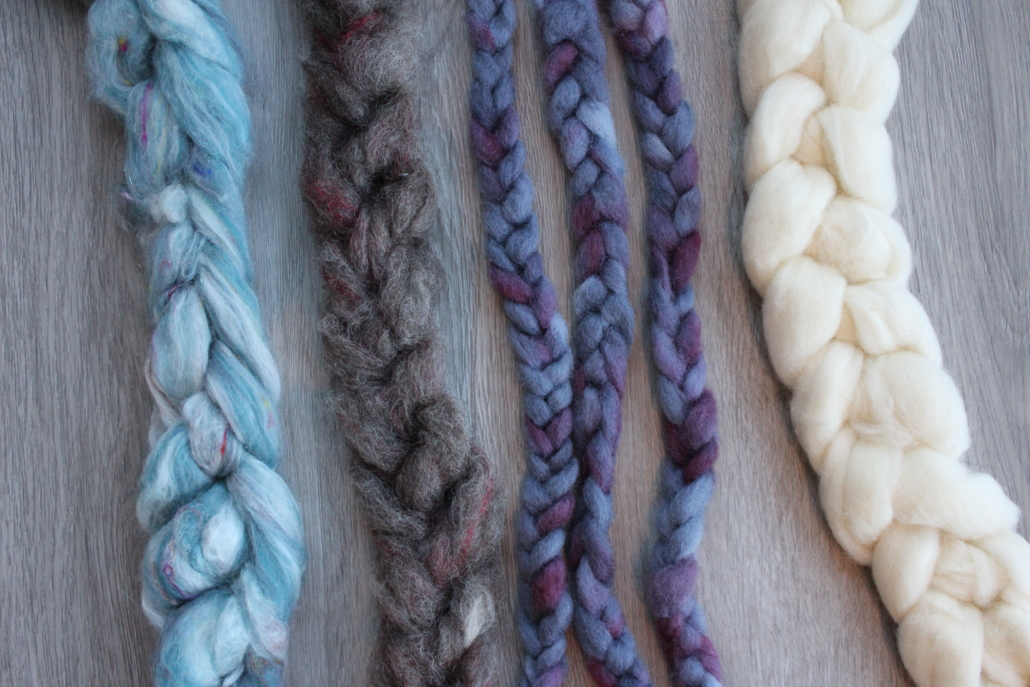
Spinning the roving
I spun Heidi’s, Jami’s, and Sheri’s rovings in the same manner from start to final yarn. I pre-drafted each roving to give me more control over the fibers. I spun the rovings woolen, using a long, backwards draw. I used the slowest ratio (5.5:1) on my spinning wheel to spin the singles to avoid overtwisting the yarn. I then plied each batch of singles from center-pull balls to make balanced 2-ply yarns, using a medium speed ratio of (7.5:1). I washed my freshly spun yarns in a warm, soapy water bath and rinsed them in water of the same temperature. Once the yarns were rinsed, I gave them the “whack” treatment against the edge of my sink to set the twist and hung the yarns to dry. The resulting yarns were fluffy and had the slight halo that makes woolen style spinning so wonderful!
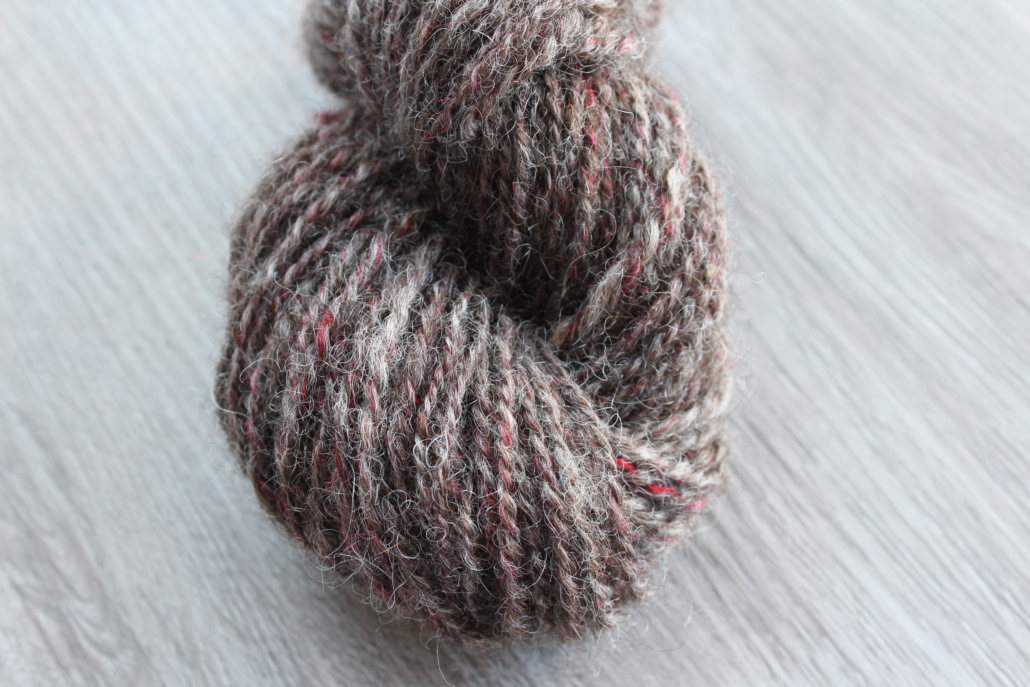
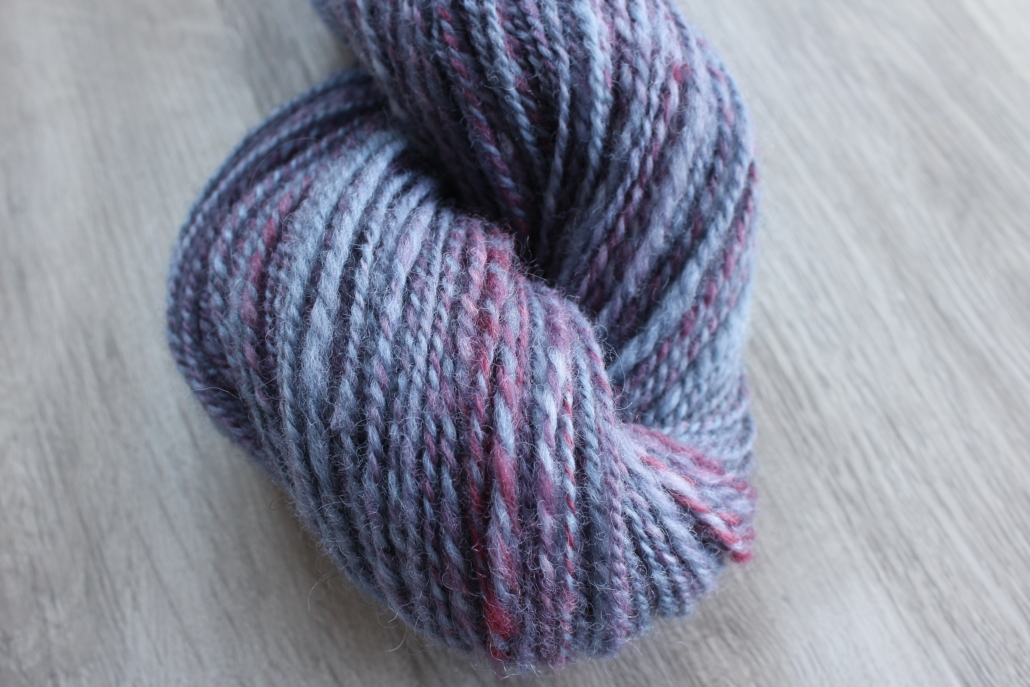
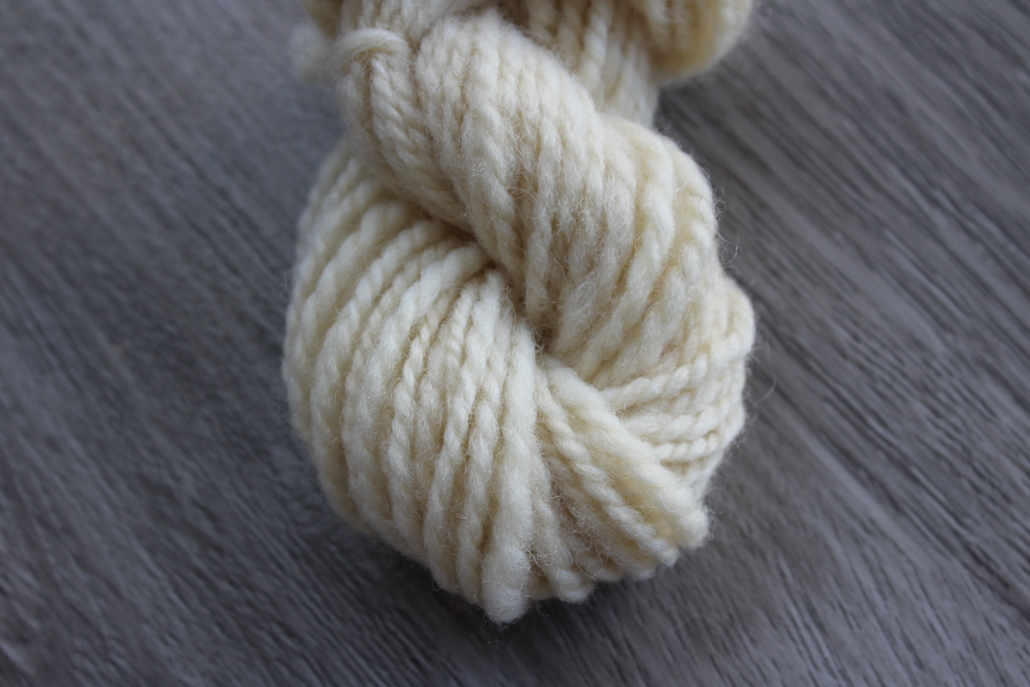
Arlene’s roving had a large amount of texture, and I felt the best way to harness that texture was to make an art yarn. Thus, I spun Arlene’s roving into woolen thick-and-thin singles, with a short forward draw. To avoid overtwisting the yarn, I used the slowest ratio (5.5:1) of my wheel for spinning the singles and plying. I then plied those singles using a commercial silver-nylon thread with sequins. I bathed the yarn in cold water to set the twist, squeezed out the excess water, and hung the yarn to dry. The result of the spin was a fantastic flame-style art yarn. I was struck at how the color combination was reminiscent of the look of the clouds in the Pacific Northwest at the beginning of a storm, with the silver thread flashing like hints of lightning and the sequins falling like delicate raindrops throughout the yarn. It really showcased the potential of using a farm blend roving to spin art yarn.
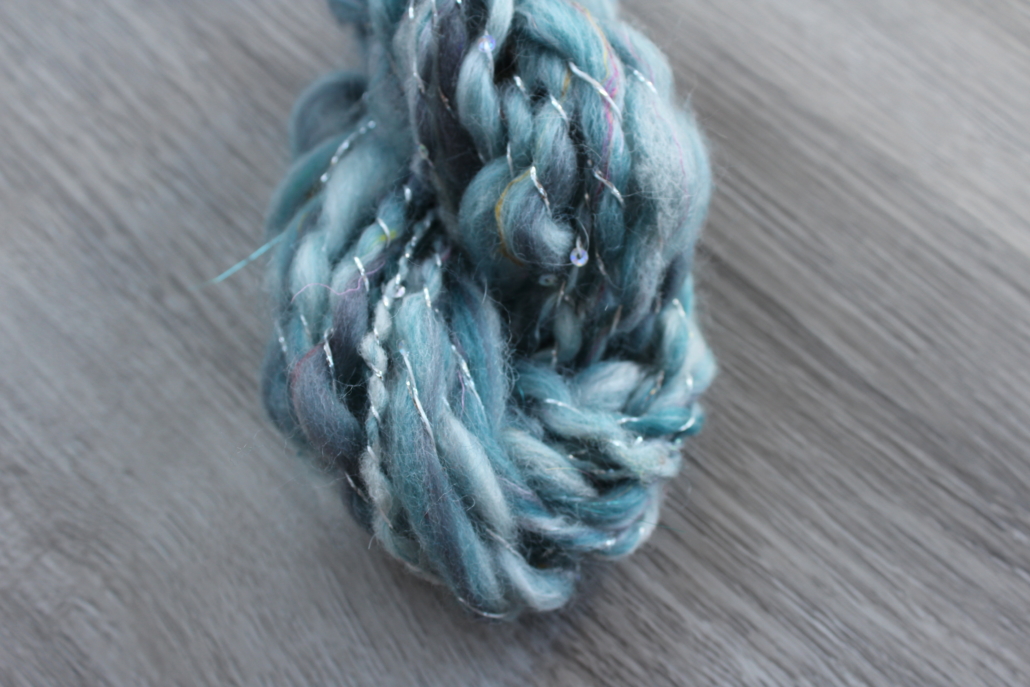
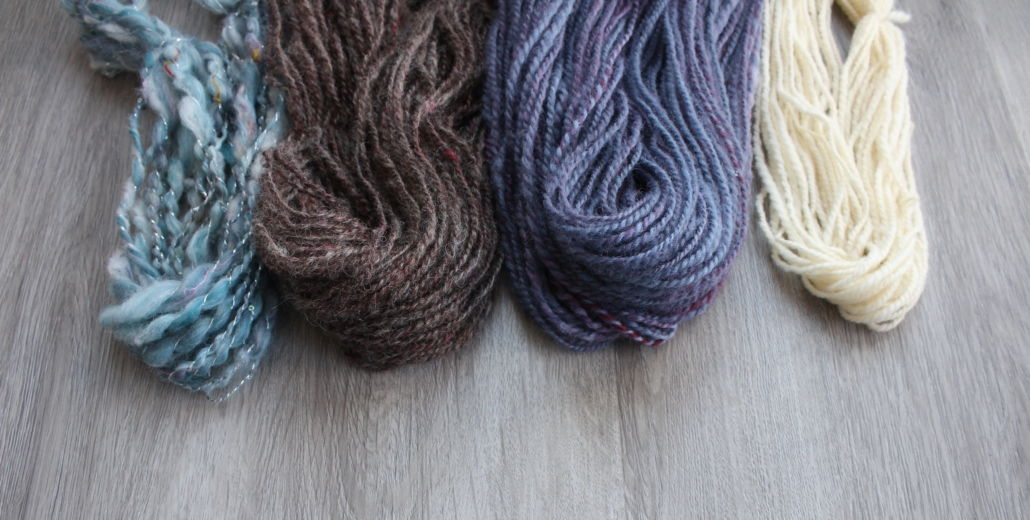
Where do you get it?
You can start your fiber quest for farm blend roving by exploring local yarn shops, fiber arts festivals, or handspinning guilds, whether in person or virtually. You can also look at breed associations or search your favorite social media platform, such as Instagram, to find farms which raise fiber animals and contact them directly.
Farm blend roving guidelines
1. It should contain fibers from animals raised by the producer of the roving.
2. It is a woolen fiber preparation.
3. It can be hand processed or professionally milled.
4. It can be a unique mix of protein fibers, plant fibers, and/or synthetic fibers.
Tips for choosing farm blend roving
Choosing farm blend roving is subjective and depends on the needs of the handspinner.
It may be helpful to ask yourself the following questions: Is there a particular color I am drawn to? Does the texture or feel of the fibers speak to me? Have I already spun most of the fibers individually and want to try them spun together? Am I looking to try fibers that are new to me?
Be aware of the possible presence of some vegetable matter in farm blend roving, but don’t panic. It should fall out as you spin it. Also, make sure you have enough for your desired project. A farm blend roving is like a yarn dye lot – unique and irreplaceable. In terms of fiber volume, I find that 8 ounces of farm blend roving is enough for most small to medium spin projects (e.g., mittens, hat, or shawl).
Using it
There are many ways to use yarn spun from farm blend roving; however, to help me find the right project, I like to use the softness of a yarn after finishing as a guide. For example, a soft yarn can be used for next-to-the skin projects like cowls. A medium-soft yarn can be used for hats or mittens. A coarse yarn can be used for outerwear like a vest or socks.
Note: If a yarn spun from a farm blend roving does not work for your intended project, chances are high that the yarn you spun will be so gorgeous that it could be used “as is” to decorate your studio!
In conclusion
Take a step off the beaten path and partake in an exciting spinning experience that also helps fiber farmers continue to care for their fiber animals. Go forth – imagine and create handspun yarns from farm blend roving that you will treasure. Don’t forget to use the tag #inspiredbyPLY on your social media channels so others in the spinning community can admire your projects and be inspired!

Jacqueline Harp is a freelance writer and multimedia fiber artist who spins, felts, weaves, crochets, and knits in every spare moment possible. She is also a certified Master Sorter of Wool Fibers through the State Univ. of N.Y. (Cobleskill) Sorter-Grader-Classer (SGC) Program. Her Instagram handle is @foreverfiberarts
PLY Magazine believes that Black lives matter, as well as LBGTQI+ lives. Those most vulnerable and persecuted in our communities deserve our love and support. Please be good to each other.
Did you know we also have a monthly PLY newsletter? Sign up here!

